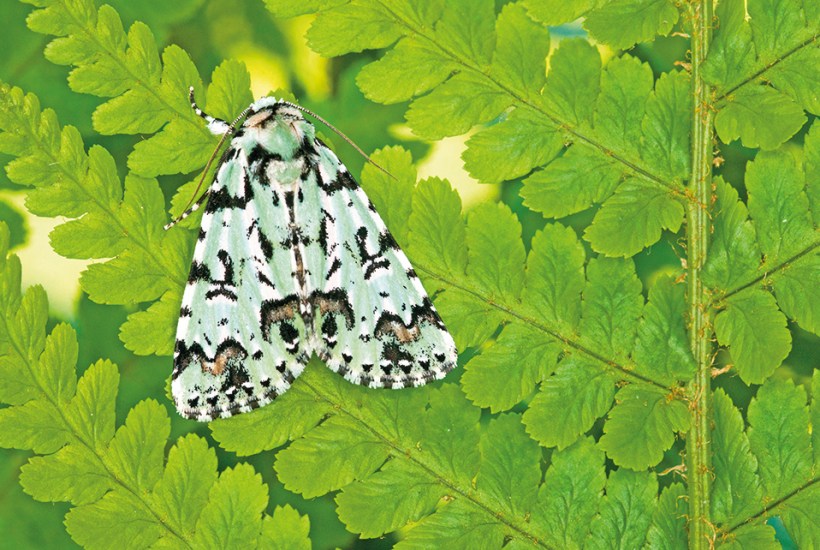Over the years, I too have regularly been meeting with moths. So far, I have encountered 891 species just in my own garden in Sussex. But most of these moths came to me: I have an ancient metal Robinson trap, inherited from my grandfather, which lures them to a mercury vapour bulb. Katty Baird, how-ever, despises ‘all-too-easy light traps’. (‘One of my most rewarding experiences with a moth trap was at an old people’s home…’) She is proactive, even hyperactive, in seeking out her quarry across East Lothian, ranging from moorland cliffs and caves to the ‘car park toilet block near my children’s primary school’. Meetings with Moths, by an ‘extreme moth-er’, makes me feel like a decadent southerner, bloated on the relatively huge hauls in my part of the world.
We are alike, though, in our passionate love for these often maligned insects. Moths are seen as drab at best; at worst, sinister, flying by night and secretly gnawing holes in cashmere jumpers. But more than 2,500 wildly diverse species of moth have been recorded in Britain and only two of these have larvae which are likely to consume your jerseys. There are plenty of blatantly beautiful moths out there, such as the blotched velvet Garden Tiger, which has blue-spotted scarlet or yellow underwings, or the Merveille du Jour, which is indeed marvellous, marbled mint-green, silver and black. As Baird acknowledges, most moths are not vivid ‘eye-candy’, like the ‘marshmallow pink’ Elephant Hawkmoth; but even those that are predominantly brown or silvery grey have wonderfully intricate and delicate patterns in their fine-sculpted wings. Baird is especially good at evoking these subtler beauties, such as the multiple fine cross-bands on the wings of a Mallow moth, which are a confection of many shades of brown: ‘a darker central stripe shaded in hazelnut, chocolate and cinnamon, sandwiched between lighter bands of milky coffee and caramel. To finish, it is sprinkled with a frosting of sugar-white scales.’
One of the deep joys of mothing is that it makes you look harder, and the harder you look the more you see. Early on dewy summer mornings, I spend hours poring over the miniature marvels of micro moths, which are often less than 10mm in length. There is a whole new world of beauty to discover in these. The thrill is in spotting the tiny differences that enable one to lay claim to a Red Data Book species – noticing that one has a Sycamore Slender, say, rather than its lookalike cousin the Yellow Triangle Slender.
But this excitement is far too sedentary for Baird. When she does use light traps, she loads herself up with as many as four battery-operated models and hauls them up a mountain. She prefers the ‘challenge’ of the ‘active pursuit’ of daytime-flying moths, such as the Netted Mountain Moth; she tramps the moors in ‘competitive’ search for the caterpillars of the rare Rannoch Brindled Beauty. (Neither of these is resident in Sussex: the Rannoch Loopers which I have encountered were migrants from Europe.)
In the winter months, when catches are low, and most of us are busily typing up our records for the County Recorder, Baird becomes even more hyperactive. Like the Winter Moth, she seems to have antifreeze in her veins; and, undaunted, sets off to track down the lairs of over-wintering moths in ruined castles, down abandoned mines and in caves and culverts across southern Scotland. This is her ‘obsessional niche’, and she discovered the first over-wintering Tissue moths in Scotland. In the quest
we’ve scaled precipitous cliffs, traversing ledges (in wellies) I’d rather not remember; been sleet-soaked on wind-blasted moorlands; had our skin punctured by battles with spiky gorse thickets…
One senses she would not have it any other way. Looking for Lunar Hornet moths, she prefers battling through face-high nettles to using a pheromone lure: ‘It seemed too easy, a cheat’s way to see a moth.’ There is a distinctly puritanical streak in these winter expeditions. I am reminded of the Cameron chieftain rebuking his nephew for rolling a snowball as a pillow, chiding him for being ‘a luxurious’.
Baird’s children are largely unimpressed, not to say embarrassed, by a mother who is apt to dive with a torch into culverts behind the local supermarket, emerging to go through the checkout with brambles matted in her hair. ‘I can always tell when you’ve had a bath,’ says her daughter. ‘You leave bits of moss and twig behind.’ Other cherished comments include: ‘You stink of cave again’ and ‘You don’t need to come into the playground to pick us up’.
Families of addicts always suffer. I remember one enthusiast who rang up when I started trapping Bisigna procerella, a tiny, enchantingly pretty orange-and-silver moth which is a proposed Red Data Book species. He had already driven down from the Midlands and booked into a nearby B&B. Fortunately, more specimens arrived before his holiday was up and he dashed around brandishing an enormous camera. In tow were a laboriously patient wife and a thunderously sulky teenage son for whom this was clearly not the holiday of their choice.
I hope Baird’s children are proud of her now. They should be. This is a lovely book, which evokes the thrill of the chase for mothers of every variety.
Got something to add? Join the discussion and comment below.
Get 10 issues for just $10
Subscribe to The Spectator Australia today for the next 10 magazine issues, plus full online access, for just $10.
You might disagree with half of it, but you’ll enjoy reading all of it. Try your first month for free, then just $2 a week for the remainder of your first year.














Comments
Don't miss out
Join the conversation with other Spectator Australia readers. Subscribe to leave a comment.
SUBSCRIBEAlready a subscriber? Log in